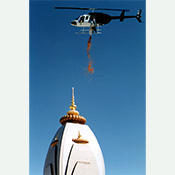 The number of Hindu temples in the United States has grown rapidly in the last decades, creating a landscape of varied expressions and structures within American Hinduism that parallels both the sites and histories of India and the value of pluralism in the United States.
The number of Hindu temples in the United States has grown rapidly in the last decades, creating a landscape of varied expressions and structures within American Hinduism that parallels both the sites and histories of India and the value of pluralism in the United States.
View full album
As the Hindu tradition has grown in America, the landscape of Hindu America has come to duplicate the sacred geography of India. Just as the Pilgrims spoke of “New England” and named Boston, New London, and New York for places back home in England, so do today’s Hindu Americans recreate the significant features of Hindu India. Vishnu Balaji’s great shrine at Tirupati in South India can be found in Pittsburgh at the Sri Venkateswara temple. Rama’s birthplace and capital at Ayodhya is in the suburbs of Chicago. In the hills of West Virginia is New Vrindavan, named for the hometown of Krishna in India. In Schuylkill Haven, Pennsylvania and Holbrook, Massachusetts, there is Vraj (or Braj), also Krishna’s homeland. The temple in Holbrook is unique in its adaptation—the mandir itself is a renovated Friendly’s restaurant. In Austin, Texas is a lavish temple called Barsana Dham, named for the hometown of Radha, Krishna’s sweetheart. And in Flint, Michigan there is a Pashchima Kashi Temple, literally the “Kashi of the West,” bringing Shiva’s sacred city to America’s midwest. The Geeta Temple in Elmhurst, New York includes all twelve of India’s famous Shiva shrines, called the jyotirlingas or “lingas of light”, as well as a recreation of the hilltop shrine of Vaishno Devi from northwest India.
As Hindus put down roots in America, they also articulate a distinctively Hindu vision of America: the pluralism of many religious traditions and ways. “America is based on an important Hindu ideal,” said a Michigan businessman. “We say ‘Truth is one, the ways are many.’ America is one country, with one ideal of freedom and democracy. But the religions of America are many. There is room for all ways here.”